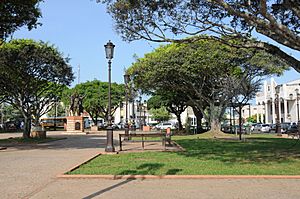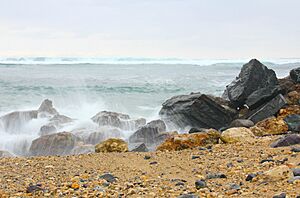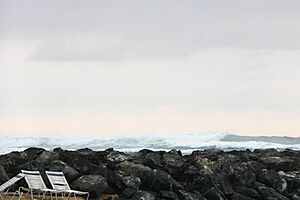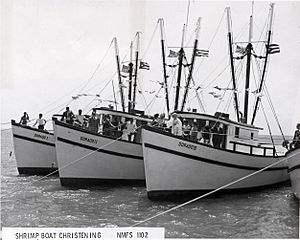Dorado, Puerto Rico facts for kids
Quick facts for kids
Dorado
Municipio Autónomo de Dorado
|
|||
|---|---|---|---|
|
Town and municipality
|
|||

Main square in Dorado
|
|||
|
|||
| Nicknames:
"La Ciudad Ejemplar", "Ciudad Dorada", "La Más Limpia de Puerto Rico"
|
|||
| Anthem: "Por fin, en las riberas" | |||

Map of Puerto Rico highlighting Dorado Municipality
|
|||
| Sovereign state | United States | ||
| Commonwealth | Puerto Rico | ||
| Settled | late 16th century | ||
| Founded | May 13, 1842 | ||
| Founded by | Jacinto López Martínez | ||
| Barrios | |||
| Area | |||
| • Total | 23.23 sq mi (60.16 km2) | ||
| Population
(2020)
|
|||
| • Total | 35,879 | ||
| • Rank | 31st in Puerto Rico | ||
| • Density | 1,544.65/sq mi (596.39/km2) | ||
| • Racial groups (2020 Census) |
17.6% White Puerto Ricans 7.5% Afro-Puerto Ricans 0.4% American Indian/AN 0.3% Asian 0.0% Native Hawaiian/PI 25.8% other 48.5% two or more races |
||
| Demonym(s) | Doradeños | ||
| Time zone | UTC−4 (AST) | ||
| ZIP Code |
00646
|
||
| Area code(s) | 787/939 | ||
| Major routes | |||
Dorado (Spanish pronunciation: [doˈɾaðo]) is a beautiful town and municipality on the northern coast of Puerto Rico. It is about 15 kilometers (9 miles) west of San Juan, the capital city. Dorado is located in the northern part of the island, right next to the Atlantic Ocean. It shares borders with Toa Alta to the south, Vega Alta to the west, and Toa Baja to the east.
Dorado is divided into five areas called barrios and Dorado Pueblo, which is the downtown area and the main center of the city. In the early 1700s, people already talked about a "Sitio de Dorado" (meaning a golden place) in old records from San Juan. For a long time, until 1831, Dorado was just a part of the town of Toa Baja. As Dorado grew, it formed its own town center, which people called the "new pueblo." This helped tell it apart from Toa Baja, which became known as the "old pueblo." The people of the "new pueblo" eventually wanted to become their own separate town.
On November 22, 1842, a local leader named Jacinto López Martínez asked the Spanish Governor of Puerto Rico, Santiago Méndez Vigo, to make Dorado its own municipality. The governor agreed, but only if they built public buildings like an administrative office and a church near the town square. By 1848, these buildings were finished, and López Martínez became Dorado's first mayor. After the Spanish–American War in 1898, Puerto Rico became a territory of the United States. In 1902, Dorado was briefly joined back with Toa Baja, but by 1905, it became a separate town again. Today, Dorado has modern neighborhoods and a charming downtown area with a main square, just like many other towns in Puerto Rico. The town celebrates its patron saint, Anthony of Padua, with special events in the main square every year on June 13.
Contents
History of Dorado
Early Beginnings
In the early 1700s, there were already mentions of a "Sitio de Dorado" in old records from San Juan. This means the area was known even before it became a formal town.
For many years, until 1831, Dorado was just a barrio (a type of neighborhood or ward) of the town of Toa Baja. As Dorado grew, it developed its own town center. People called this new center the "new pueblo" to tell it apart from Toa Baja, which they called the "old pueblo." The people living in the "new pueblo" eventually wanted their area to become its own independent town.
Becoming a Municipality
On November 22, 1842, Jacinto López Martínez, who was a local leader in Dorado, asked the Spanish Governor of Puerto Rico, Santiago Méndez Vigo, to make Dorado a separate municipality. The governor said yes, but only if they built important public buildings. These included an administrative building and a church near the town square.
By 1848, the construction of these buildings was finished. After this, López Martínez became the first mayor of Dorado. This was a big step for the community, giving it its own local government.
Modern Times
After the Spanish–American War in 1898, Puerto Rico became a territory of the United States. In 1902, Dorado was briefly made part of Toa Baja again. However, just three years later, in 1905, Dorado officially became a separate town once more.
Geography of Dorado
Dorado's land is mostly made up of sand, clay, and other materials from rivers and the coast. It also has limestone rocks, especially in the southern parts like Espinosa, Maguayo, and Rio Lajas. These limestone areas have beautiful karst landscapes, which are unique rock formations.
Water Features
Dorado is home to several important bodies of water. These include:
- Rivers: Río Cocal, Río Lajas, Río de la Plata, and Río Nuevo.
- Mata Redonda lagoon
- Punta Fraile marsh
Climate in Dorado
Dorado has a warm climate. Summers are hot, and winters are cooler. Temperatures usually range from about 16°C (60°F) to 27°C (80°F) in winter. In summer, temperatures are typically between 24°C (75°F) and 35°C (95°F).
| Climate data for Dorado, Puerto Rico | |||||||||||||
|---|---|---|---|---|---|---|---|---|---|---|---|---|---|
| Month | Jan | Feb | Mar | Apr | May | Jun | Jul | Aug | Sep | Oct | Nov | Dec | Year |
| Record high °F (°C) | 90 (32) |
91 (33) |
95 (35) |
97 (36) |
98 (37) |
100 (38) |
99 (37) |
98 (37) |
101 (38) |
99 (37) |
95 (35) |
93 (34) |
101 (38) |
| Mean daily maximum °F (°C) | 78 (26) |
80 (27) |
83 (28) |
84 (29) |
88 (31) |
91 (33) |
92 (33) |
92 (33) |
90 (32) |
87 (31) |
82 (28) |
81 (27) |
86 (30) |
| Mean daily minimum °F (°C) | 63 (17) |
64 (18) |
66 (19) |
70 (21) |
72 (22) |
73 (23) |
77 (25) |
77 (25) |
77 (25) |
75 (24) |
69 (21) |
66 (19) |
71 (22) |
| Record low °F (°C) | 50 (10) |
49 (9) |
50 (10) |
59 (15) |
62 (17) |
67 (19) |
68 (20) |
68 (20) |
69 (21) |
60 (16) |
55 (13) |
53 (12) |
49 (9) |
| Average precipitation inches (mm) | 3.55 (90) |
3.11 (79) |
— | 2.78 (71) |
3.55 (90) |
7.20 (183) |
6.20 (157) |
5.84 (148) |
5.60 (142) |
3.71 (94) |
8.47 (215) |
5.65 (144) |
— |
| Source: The Weather Channel | |||||||||||||
Culture and Fun in Dorado
Tourism and Resorts
Dorado is a great place for tourists! The Puerto Rico Tourism Company has a special program called Voy Turistiendo (meaning "I'm Touring"). It helps people discover places like the Salvador Rivera Cardona Exhibition Hall, the 5th Centenary Commemorative Plaza, and the Manuel "Nolo" Morales Beach.
Dorado's culture mixes traditional Puerto Rican elements, especially from African and Spanish influences. You can also see some Taíno (native people) influences, mostly in the food. Many famous artists from Dorado, like Juan Boria and Horacio Olivo, have helped share the local culture.
Dorado is also famous for its golf courses. It has several resorts, including the Dorado Beach Resort and the Hyatt Hacienda del Mar. These places offer beautiful golf courses and other fun activities.
Cool Places to Visit
Dorado has many beautiful beaches. There are 24 beaches in total, including the popular Manuel Nolo Morales Beach.
Many interesting places to visit are in downtown Dorado. The Casa del Rey Museum is a historic house. It was built for the King and Queen of Spain to stay in if they ever visited. The museum has many old items from that time. You can also visit the Distinguished Doradeños Square and the Juan Boria Theater. The theater has been recently restored and reopened.
Other popular beaches in Dorado include Sardinera, Kikita, and El Unico. These are great spots for surfers. The Ojo del Buey Park is a unique park located by the La Plata River. Its name, "Ox's Eye," comes from a rock formation that looks like an ox. The Dorado Pterocarpus Forest is also a beautiful natural area in the municipality.
Dorado also has a church called the Sanctuary of Christ of the Reconciliation. Inside, it has the third-largest statue of Jesus Christ in the Caribbean. During Christmas, there are many celebrations, including special masses and traditional parties where people dress up and play music.
Festivals and Events
Dorado loves to celebrate! The Fiestas a la Santa Cruz have been celebrated since the town was founded. Dorado also has its main patron saint festival in June, honoring Antonio de Padua. These celebrations include religious events, cultural activities, music contests, and fun carnival rides. There's even a special "Day of the Absent Doradeños" for people who live away from Dorado to come back and celebrate. Other events include horse races, sack races, and eating contests.
Before the Christian season of Lent, Dorado hosts a carnival. This event features colorful characters and parades. Other festivals and events in Dorado include:
- Three Kings’ Day Festival – January
- Del Plata Carnival – February
- Minin Kuilan Gold Cup – April
- Cocolía Crab Festival– August
- Town and Country Festival – September
- Discovery of Puerto Rico / Puerto Rican Culture Festival – November
- Christmas Festival – December
Arts and Learning
Dorado has a rich history of arts and learning. Famous writers like José S. Alegría and poets like Ferdinand R. Cestero are from Dorado. The town has a Cultural Center that helps promote arts and culture.
Many local artists have contributed to Dorado's vibrant arts scene. In the past, there were weekly bomba dances, a traditional Puerto Rican music and dance style. There are also many folkloric dance groups. Dorado has also produced talented musicians and painters. The Juan Boria Theater and an arts school help teach dramatic arts to young people.
Sports and Athletes
Dorado has a strong sports community. The town hosts a marathon in November. Paso Fino, a special horse riding sport, is very popular here. The Kuilan family is well-known for their skills in this sport.
Dorado has produced many talented athletes. These include baseball players like Manolín Maldonado and Angel Maysonet, and boxers like Tony Villa. Dorado also has its own Double A baseball team called Los Guardianes (The Guardians). It's also a popular place for golf and tennis. In professional wrestling, Ray González and Damian Priest grew up in Dorado.
Dorado's Economy
Farming and Agriculture
In 2007, Dorado had ten farms. These farms grew various crops like plantains, coffee, vegetables, and bananas. They also raised animals such as cattle, horses, and pigs. Some of the main crops grown were lawn grass, coffee, and cassava.
Businesses and Industry
Dorado's economy relies on tourism and pharmaceutical companies. Many companies that make clothing and medical equipment are located here. Big companies like Boston Scientific, Pfizer, and Heraeus have facilities in Dorado.
Homes and Neighborhoods
In recent years, Dorado has become known for its fancy neighborhoods. Many well-known politicians and artists, like Ricky Martin and Carlos Romero Barceló, own homes or live in Dorado.
People of Dorado (Demographics)
| Historical population | |||
|---|---|---|---|
| Census | Pop. | %± | |
| 1900 | 3,804 | — | |
| 1910 | 4,885 | 28.4% | |
| 1920 | 5,842 | 19.6% | |
| 1930 | 7,579 | 29.7% | |
| 1940 | 9,481 | 25.1% | |
| 1950 | 11,749 | 23.9% | |
| 1960 | 13,460 | 14.6% | |
| 1970 | 17,388 | 29.2% | |
| 1980 | 25,511 | 46.7% | |
| 1990 | 30,759 | 20.6% | |
| 2000 | 34,017 | 10.6% | |
| 2010 | 38,165 | 12.2% | |
| 2020 | 35,879 | −6.0% | |
| U.S. Decennial Census 1899 (shown as 1900) 1910–1930 1930–1950 1960–2000 2010 2020 |
|||
Dorado's population has grown a lot over the last century. In 2000, there were 34,017 people living there. By 2010, the population reached 38,165. However, the 2020 census showed a small decrease to 35,879 people.
Most people in Puerto Rico have Spanish or European backgrounds. There are also smaller groups of people with African and Asian backgrounds. In Dorado, based on the 2000 census, about 74.1% of people identified as having Spanish or White origins. About 12.2% identified as Black, and 0.5% as Native American.
Religious Beliefs
Because of Spanish influence, most people in Dorado practice Catholicism. There are also other religious groups in the town, including the Getsemaní Lutheran Church, which was founded in 1911.
Symbols of Dorado
Dorado has its own official flag and coat of arms, which represent the town.
Dorado's Flag
The flag of Dorado has three stripes that are all the same width. The top and bottom stripes are golden, and the middle stripe is brown. There is also a brown triangle on the left side of the flag.
Dorado's Coat of Arms
The coat of arms has a gold crown with brown windows at the top. The three towers on the crown show that Dorado is a properly formed municipality. Below the crown, there are five circles that form a Tau symbol.
Education in Dorado
Dorado has many public and private schools. The Puerto Rico Department of Education manages the public schools.
Some of the main schools include:
- José S. Alegría High School (public)
- Ricardo Arroyo Middle School (7th to 9th Grade)
- Jacinto López Martínez Elementary School (one of the oldest and largest schools)
- Dorado Academy (private)
- TASIS Dorado (private)
- The Jane Stern Dorado Community Library, founded in 1974, is Puerto Rico's first public library that offers books in both English and Spanish.
Getting Around Dorado (Transportation)
You can reach Dorado using Puerto Rico Highway 22 from cities like Mayagüez or San Juan. Road 165 also leads to Dorado from Cataño and Bayamón, following the coast. It takes about 30 minutes to drive to Dorado from San Juan.
Like many towns on the island, Dorado has public transportation, including public cars and taxis. There is also a public trolley system and a shuttle service for people with disabilities.
Dorado has 19 bridges. The Dorado Airport used to have commercial flights, but it is now closed.
Famous People from Dorado
- José S. Alegría, a poet, writer, lawyer, and politician.
- Juan Boria, a poet.
- Onix Concepción, a Major League Baseball shortstop.
- Damian Priest, a professional wrestler and former WWE World Champion.
See also
 In Spanish: Dorado (Puerto Rico) para niños
In Spanish: Dorado (Puerto Rico) para niños






